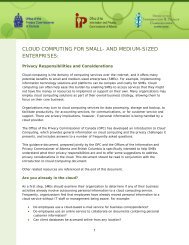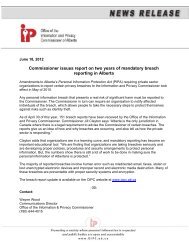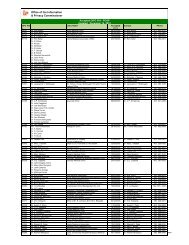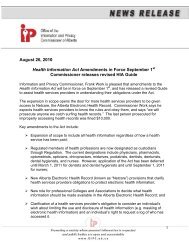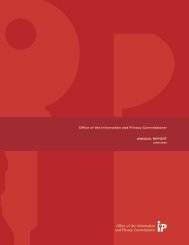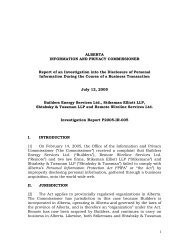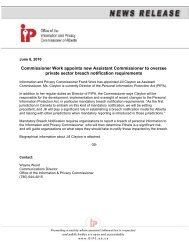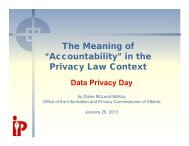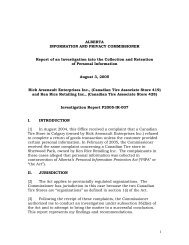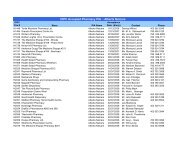PIPA Advisory 2 - Access Requests - Office of the Information and ...
PIPA Advisory 2 - Access Requests - Office of the Information and ...
PIPA Advisory 2 - Access Requests - Office of the Information and ...
Create successful ePaper yourself
Turn your PDF publications into a flip-book with our unique Google optimized e-Paper software.
<strong>Office</strong> <strong>of</strong> <strong>the</strong> <strong>Information</strong><br />
<strong>and</strong> Privacy Commissioner<br />
Suite 2460, 801 – 6 th Ave. SW<br />
Calgary, Alberta<br />
T2P 3W2<br />
Phone: (403) 297-2728<br />
Fax: (403) 297-2711<br />
Toll Free: 1-888-878-4044<br />
Web: www.oipc.ab.ca<br />
Email: generalinfo@oipc.ab.ca<br />
Personal <strong>Information</strong> Protection Act (<strong>PIPA</strong>)<br />
<strong>PIPA</strong> ADVISORY #2<br />
ACCESS REQUESTS UNDER <strong>PIPA</strong>: AN OVERVIEW<br />
This document was prepared to help organizations implement <strong>the</strong> Personal<br />
<strong>Information</strong> Protection Act. This document is an administrative tool<br />
intended to assist in underst<strong>and</strong>ing <strong>the</strong> Act. It is not intended as, nor is it<br />
a substitute for, legal advice. For <strong>the</strong> exact wording <strong>and</strong> interpretation <strong>of</strong><br />
<strong>PIPA</strong>, please read <strong>the</strong> Act in its entirety. This <strong>Advisory</strong> is not binding on<br />
<strong>the</strong> <strong>Office</strong> <strong>of</strong> <strong>the</strong> <strong>Information</strong> <strong>and</strong> Privacy Commissioner <strong>of</strong> Alberta (OIPC).<br />
Contents<br />
Introduction<br />
Introduction<br />
What is “Personal <strong>Information</strong>?”<br />
Limitations on application <strong>of</strong> <strong>the</strong> Act<br />
Who can make a request?<br />
Making a request<br />
Fees<br />
Time limits<br />
Exceptions to access<br />
Responding to a request<br />
O<strong>the</strong>r resources<br />
The Personal <strong>Information</strong> Protection Act (“<strong>PIPA</strong>” or “<strong>the</strong><br />
Act”) provides individuals with a right to access <strong>the</strong>ir<br />
own personal information contained in a record in an<br />
organization’s custody or control, <strong>and</strong> to request to have<br />
inaccurate personal information corrected.<br />
Individuals also have a right to know <strong>the</strong> purposes for<br />
which <strong>the</strong>ir personal information has been <strong>and</strong> is being<br />
used by an organization, as well as <strong>the</strong> names <strong>of</strong> <strong>the</strong><br />
persons to whom <strong>the</strong>ir personal information has been<br />
provided, <strong>and</strong> <strong>the</strong> circumstances <strong>of</strong> that disclosure.<br />
This <strong>Advisory</strong> is part <strong>of</strong> a series developed by <strong>the</strong> OIPC<br />
to assist organizations in h<strong>and</strong>ling <strong>and</strong> responding to<br />
requests for access.<br />
April 2005 1
What is<br />
“Personal<br />
<strong>Information</strong>”?<br />
Individuals, including both current <strong>and</strong> former<br />
employees <strong>of</strong> an organization, have a right <strong>of</strong> access to<br />
<strong>the</strong>ir own personal information. Personal information is<br />
defined in section 1(k) <strong>of</strong> <strong>the</strong> Act to mean “information<br />
about an identifiable individual.” To meet this definition,<br />
<strong>the</strong> information must ei<strong>the</strong>r readily identify <strong>the</strong><br />
individual, or <strong>the</strong> identity <strong>of</strong> <strong>the</strong> individual can be<br />
determined from <strong>the</strong> information. If <strong>the</strong> individual<br />
cannot be identified, <strong>the</strong> information is not “personal<br />
information” under <strong>the</strong> Act.<br />
Example: An organization videotapes a man whose<br />
features cannot be seen, <strong>and</strong> whose mannerisms <strong>and</strong><br />
clothing do not identify him. As <strong>the</strong> identity <strong>of</strong> <strong>the</strong> man<br />
on <strong>the</strong> tape cannot be determined, <strong>the</strong> videotape is not<br />
“personal information” under <strong>the</strong> Act.<br />
Example: A tape recording is made <strong>of</strong> a woman having a<br />
conversation with a friend in which <strong>the</strong> woman’s name<br />
<strong>and</strong> address are mentioned. The recording is “personal<br />
information” because <strong>the</strong> woman can be identified.<br />
Personal information is not limited to factual<br />
information about an individual, but also includes<br />
someone’s opinion, evaluation or comments about<br />
ano<strong>the</strong>r individual.<br />
Example: An employee’s supervisor writes in a<br />
performance appraisal that <strong>the</strong> employee is “unreliable<br />
as he does not finish projects by <strong>the</strong> agreed upon<br />
deadlines.” The supervisor’s evaluation is personal<br />
information <strong>of</strong> <strong>the</strong> employee being reviewed.<br />
<strong>Information</strong> about an identifiable individual is personal<br />
information regardless <strong>of</strong> <strong>the</strong> medium or form in which<br />
it is stored. It includes information in written, printed,<br />
photographic or electronic form. If a conversation that<br />
includes personal information is recorded, e.g. on tape<br />
or in notes, <strong>the</strong> personal information contained in that<br />
record is subject to <strong>the</strong> Act.<br />
April 2005 2
While <strong>the</strong> Act applies to personal information whe<strong>the</strong>r<br />
recorded or not, an individual only has a right <strong>of</strong> access<br />
to recorded personal information.<br />
Examples:<br />
• A photograph or videotape from a security<br />
camera that clearly captures an identifiable<br />
individual<br />
• Names <strong>and</strong> addresses <strong>of</strong> customers stored in an<br />
electronic database in a department store’s<br />
computer system<br />
• Notes in a supervisor’s file about an identifiable<br />
employee<br />
• A conversation in a hallway about a co-worker’s<br />
recent illness, where no notes or recordings are<br />
made, is not recorded personal information<br />
Limitations on<br />
application <strong>of</strong><br />
<strong>the</strong> Act<br />
Not all personal information is covered by <strong>the</strong> Act. For<br />
example, <strong>the</strong> Act does not apply to business contact<br />
information where it is collected, used or disclosed<br />
solely for <strong>the</strong> purpose <strong>of</strong> contacting an individual in his<br />
or her business capacity.<br />
Business contact information is defined in <strong>the</strong> Act to<br />
mean an individual’s name, position name or title,<br />
business telephone number or address, e-mail, fax<br />
number, <strong>and</strong> o<strong>the</strong>r similar business information.<br />
O<strong>the</strong>r examples <strong>of</strong> information that is not governed by<br />
<strong>PIPA</strong> are listed in Section 4(3) <strong>of</strong> <strong>the</strong> Act <strong>and</strong> include,<br />
but are not limited to, personal information:<br />
• personal information to which <strong>the</strong> Alberta Freedom <strong>of</strong><br />
<strong>Information</strong> <strong>and</strong> Protection <strong>of</strong> Privacy Act applies;<br />
• collected, used or disclosed solely for personal or<br />
domestic (home <strong>and</strong> family) purposes<br />
• collected, used or disclosed solely for artistic, literary<br />
or journalistic purposes<br />
• about an individual who has been dead for at least<br />
20 years or contained in a record that came into<br />
existence at least 100 years ago; or<br />
• contained in a court file or judicial record as<br />
described in <strong>the</strong> Act<br />
April 2005 3
• created by or on behalf <strong>of</strong> a Member <strong>of</strong> <strong>the</strong><br />
Legislative Assembly.<br />
If <strong>the</strong> Act does not apply to <strong>the</strong> information, individuals<br />
do not have a right <strong>of</strong> access under <strong>PIPA</strong>.<br />
Who can<br />
make a<br />
request?<br />
Individuals can request access to <strong>the</strong>ir own personal<br />
information. The Act also provides that a request<br />
can be made by <strong>the</strong> following:<br />
• a minor child (under 18 years <strong>of</strong> age) who<br />
underst<strong>and</strong>s <strong>the</strong> right <strong>of</strong> access <strong>and</strong> <strong>the</strong><br />
consequences <strong>of</strong> exercising that right (a “mature<br />
minor”)<br />
• a legal guardian <strong>of</strong> a minor child<br />
• <strong>the</strong> personal representative <strong>of</strong> a deceased individual,<br />
if related to administration <strong>of</strong> <strong>the</strong> deceased’s estate<br />
• <strong>the</strong> individual’s guardian or trustee under <strong>the</strong><br />
Dependent Adults Act, if related to <strong>the</strong> powers <strong>and</strong><br />
duties <strong>of</strong> that guardian or trustee<br />
• <strong>the</strong> individual’s agent under a personal directive, if<br />
related to that agent’s powers under <strong>the</strong> directive<br />
• <strong>the</strong> individual’s attorney under a power <strong>of</strong> attorney, if<br />
related to <strong>the</strong> powers <strong>and</strong> duties conferred on that<br />
attorney<br />
• any person with written authorization from <strong>the</strong><br />
individual to act on <strong>the</strong> individual’s behalf<br />
Only an individual has a right <strong>of</strong> access, but a person<br />
o<strong>the</strong>r than an individual could make a request on behalf<br />
<strong>of</strong> an individual. Corporations <strong>and</strong> o<strong>the</strong>r entities are not<br />
individuals under <strong>the</strong> Act.<br />
Making a<br />
request<br />
Section 26 <strong>of</strong> <strong>the</strong> Act requires that a request for access<br />
be made in writing to an organization.<br />
Organizations must make every effort to assist<br />
applicants who are unable to make a written request.<br />
For example, <strong>the</strong> organization can discuss <strong>the</strong> request<br />
with <strong>the</strong> applicant, record <strong>the</strong> details, <strong>and</strong> try to obtain<br />
<strong>the</strong> applicant’s signature. Alternatively, <strong>the</strong>re may be a<br />
third party who can assist <strong>the</strong> applicant in writing out<br />
<strong>the</strong> request.<br />
April 2005 4
If <strong>the</strong> applicant is able to make a written request, but<br />
refuses to do so, <strong>the</strong> organization is not required to<br />
proceed until a written request is received.<br />
The Act does not prevent organizations from responding<br />
to a verbal or email access request. However, an<br />
organization must ensure that it discloses personal<br />
information only to <strong>the</strong> individual <strong>the</strong> information is<br />
about or to a person authorized to exercise <strong>the</strong> right <strong>of</strong><br />
<strong>the</strong> individual.<br />
The Act does require <strong>the</strong> applicant to provide sufficient<br />
detail to enable <strong>the</strong> organization to identify <strong>the</strong><br />
requested information. The request should be clear<br />
enough to allow a reasonable person, with a working<br />
knowledge <strong>of</strong> <strong>the</strong> business <strong>and</strong> its records, to determine<br />
what <strong>the</strong> individual wants.<br />
TIP: To assist individuals in making a request for<br />
access, organizations may want to develop a request<br />
form that can be filled out by applicant, <strong>and</strong> that<br />
provides information <strong>the</strong> organization needs to respond<br />
to <strong>the</strong> request. The form can be made available in both<br />
hard copy <strong>and</strong> electronic (printable) format. A sample<br />
form is attached to this <strong>Advisory</strong>.<br />
An applicant may ask for a copy <strong>of</strong> <strong>the</strong> record, or ask to<br />
examine <strong>the</strong> record containing personal information.<br />
Fees<br />
Section 32 <strong>of</strong> <strong>the</strong> Act allows an organization to charge a<br />
“reasonable” fee in providing an individual access to<br />
personal information.<br />
Organizations cannot charge fees when responding to<br />
requests for correction, or for providing access to<br />
personal employee information.<br />
For more information on fees for access to personal<br />
information, see <strong>PIPA</strong> <strong>Advisory</strong> #5 <strong>Access</strong> <strong>Requests</strong><br />
Under <strong>PIPA</strong>: Fees.<br />
Time limits<br />
<strong>PIPA</strong> requires that an organization respond to an<br />
applicant’s request for access within 45 days <strong>of</strong><br />
receiving <strong>the</strong> written request, unless <strong>the</strong> time limit has<br />
been extended as allowed under section 31 <strong>of</strong> <strong>the</strong> Act.<br />
April 2005 5
The 45-day time limit may be extended if <strong>the</strong><br />
organization is required to clarify a request, if a large<br />
amount <strong>of</strong> personal information is requested or must be<br />
searched, or for o<strong>the</strong>r reasons specified in <strong>the</strong> Act. The<br />
organization’s time period for responding does not<br />
include days when <strong>the</strong> organization is waiting for a<br />
response from <strong>the</strong> applicant to a fee estimate.<br />
The time limit can be affected by lack <strong>of</strong> clarity in <strong>the</strong><br />
applicant’s request, or as a result <strong>of</strong> being extended by<br />
<strong>the</strong> organization or with <strong>the</strong> Commissioner’s permission.<br />
The time limit can also be suspended while an<br />
organization awaits a response to a fee estimate<br />
provided to <strong>the</strong> applicant.<br />
For more information on timelines for responding to a<br />
request for access, see <strong>the</strong> <strong>PIPA</strong> <strong>Advisory</strong> #6 <strong>Access</strong><br />
<strong>Requests</strong> Under <strong>PIPA</strong>: Timelines.<br />
Exceptions<br />
to access<br />
An individual’s right to access personal information<br />
under <strong>the</strong> Act is not unqualified. The Act allows, <strong>and</strong> in<br />
some cases requires, organizations to refuse access to<br />
some records or parts <strong>of</strong> records.<br />
For example, under section 24(2) <strong>of</strong> <strong>the</strong> Act, an<br />
organization may refuse to provide access to personal<br />
information that:<br />
• is subject to any legal privilege<br />
• would reveal confidential commercial information<br />
• was collected for an investigation or legal proceeding<br />
• if disclosed, might result in that type <strong>of</strong> information<br />
no longer being provided to <strong>the</strong> organization, when it<br />
is reasonable that <strong>the</strong> information be provided<br />
• was collected by a mediator or arbitrator, or during<br />
<strong>the</strong> conduct <strong>of</strong> a mediation or arbitration<br />
• relates to or may be used in <strong>the</strong> exercise <strong>of</strong><br />
prosecutorial discretion<br />
Under section 24(3) <strong>of</strong> <strong>the</strong> Act, an organization shall not<br />
provide access to personal information where<br />
disclosure:<br />
• could reasonably be expected to threaten <strong>the</strong> life or<br />
security <strong>of</strong> ano<strong>the</strong>r individual<br />
April 2005 6
• would reveal personal information about an<br />
individual o<strong>the</strong>r than <strong>the</strong> applicant<br />
• would reveal <strong>the</strong> identity <strong>of</strong> an individual o<strong>the</strong>r than<br />
<strong>the</strong> applicant who has provided an opinion in<br />
confidence about <strong>the</strong> applicant, <strong>and</strong> has not<br />
consented to <strong>the</strong> disclosure <strong>of</strong> her/his identity.<br />
For more information on refusing to provide access to<br />
personal information, see <strong>PIPA</strong> <strong>Advisory</strong> #7 <strong>Access</strong><br />
<strong>Requests</strong> Under <strong>PIPA</strong>: Exceptions to <strong>Access</strong>.<br />
Responding<br />
to a request<br />
Section 29 <strong>of</strong> <strong>the</strong> Act details what information must be<br />
included in a response to an applicant’s request for<br />
access to personal information. The organization’s<br />
response must advise <strong>the</strong> applicant:<br />
• whe<strong>the</strong>r or not all or part <strong>of</strong> <strong>the</strong> records containing<br />
<strong>the</strong> applicant’s personal information will be provided<br />
• when access will be given<br />
• if access to some or all <strong>of</strong> <strong>the</strong> applicant’s personal<br />
information is refused, <strong>the</strong> reasons for <strong>the</strong> refusal<br />
<strong>and</strong> <strong>the</strong> provision(s) <strong>of</strong> <strong>the</strong> Act authorizing or<br />
requiring <strong>the</strong> refusal<br />
• <strong>the</strong> name <strong>of</strong> someone in <strong>the</strong> organization <strong>the</strong><br />
applicant can speak to about any refusal<br />
• that <strong>the</strong> applicant has <strong>the</strong> right to ask this <strong>Office</strong> to<br />
review <strong>the</strong> organization’s decision<br />
For more information on providing a response to a<br />
request for access, see OIPC <strong>Advisory</strong> #3 <strong>Access</strong><br />
<strong>Requests</strong> Under <strong>PIPA</strong>: Responding to a Request.<br />
O<strong>the</strong>r<br />
resources<br />
For more information on “personal information,” see<br />
<strong>Information</strong> Sheet 3: Personal <strong>Information</strong>, produced by<br />
Alberta Government Services, <strong>Access</strong> <strong>and</strong> Privacy<br />
Branch, <strong>and</strong> available at www.pipa.gov.ab.ca.<br />
For an overview <strong>of</strong> <strong>the</strong> Act with examples <strong>and</strong> tips for<br />
incorporating good privacy practices, see A Guide for<br />
Businesses <strong>and</strong> Organizations on <strong>the</strong> Personal<br />
<strong>Information</strong> Protection Act.<br />
The Personal <strong>Information</strong> Protection Act, A Summary for<br />
Organizations summarizes <strong>the</strong> key obligations <strong>of</strong><br />
organizations.<br />
April 2005 7
Ten Steps to Implement <strong>PIPA</strong> is a quick reference for<br />
organizations preparing for <strong>the</strong> Act.<br />
Publications are available at <strong>the</strong> web site <strong>of</strong> <strong>the</strong> <strong>Office</strong> <strong>of</strong><br />
<strong>the</strong> <strong>Information</strong> <strong>and</strong> Privacy Commissioner<br />
(www.oipc.ab.ca).<br />
Publications are also available on-line at <strong>the</strong> Alberta<br />
Government Services, <strong>Access</strong> <strong>and</strong> Privacy Branch<br />
website (www.pipa.gov.ab.ca).<br />
Visit <strong>the</strong> Queen’s Printer website to view an online<br />
version <strong>of</strong> <strong>the</strong> Act (www.qp.gov.ab.ca).<br />
April 2005 8
ATTACHMENT 1 – Request for <strong>Access</strong> to Personal <strong>Information</strong> Form<br />
<strong>Access</strong> to Records Containing Personal <strong>Information</strong><br />
Name <strong>of</strong> Applicant: _________________________________________________________<br />
Mailing Address: ____________________________________________________________<br />
Contact <strong>Information</strong> (phone #, email address, etc.): __________________________<br />
_____________________________________________________________________________<br />
Best time to call (if phone number is included): _______________________________<br />
Current or Past Employees<br />
Do you want copies <strong>of</strong> your:<br />
1. *Pension information? Yes No<br />
2. *Performance appraisals? Yes No<br />
3. *Attendance sheets? Yes No<br />
4. *Contents <strong>of</strong> your personnel file? Yes No<br />
5. *Contents <strong>of</strong> your benefits file? Yes No<br />
6. Any o<strong>the</strong>r records? Yes No<br />
If so, what records? ___________________________________________________________<br />
_______________________________________________________________________________<br />
_______________________________________________________________________________<br />
Over what time frame do you want us to search (this will help us determine<br />
whe<strong>the</strong>r archived records need to be checked)? _______________________________<br />
_____________________________________________________________________________<br />
All O<strong>the</strong>r Applicants<br />
Do you want copies <strong>of</strong>:<br />
1. *Return receipts? Yes No<br />
2. *Pre-ordered receipts? Yes No<br />
3. *Screen prints <strong>of</strong> your personal information in our computer? Yes No<br />
4. *H<strong>and</strong>written notes on telephone conversations? Yes No<br />
5. *Email correspondence? Yes No<br />
6. If <strong>the</strong> same document is held in more than one location/department, do<br />
you want multiple copies <strong>of</strong> that record even if it is identical? Yes No<br />
Are <strong>the</strong>re any o<strong>the</strong>r records containing your personal information that you are<br />
interested in receiving? If so, please provide additional details here: ___________<br />
_____________________________________________________________________________<br />
Date: __________________________ Signature: _________________________________<br />
If you have any questions about completing this form, please feel free to contact<br />
us at: ________________________________________________________________________<br />
April 2005 9
Please note that <strong>the</strong> records followed by an * may not be available. Most records<br />
are kept for limited periods. Our response will indicate when any such records<br />
were destroyed as required by our retention <strong>and</strong> destruction policies.<br />
While we have 45 calendar days to respond to your request upon receipt in our<br />
<strong>of</strong>fice, we will endeavor to respond as quickly as possible. However, if we require<br />
clarification <strong>of</strong> your request, <strong>the</strong> law allows us to extend <strong>the</strong> time limit. If this 45<br />
day time limit is extended, we will contact you before that time to provide details<br />
on <strong>the</strong> delay.<br />
The 45-day time limit for responding does not include days when we are awaiting<br />
you to respond to a fee estimate. Current employees should note that <strong>the</strong> law<br />
does not permit us to charge a fee for access to personal employee information.<br />
Depending on how sensitive <strong>the</strong> personal information contained in <strong>the</strong> requested<br />
records are, we may also contact you to acquire documentation to establish your<br />
identity.<br />
April 2005 10



